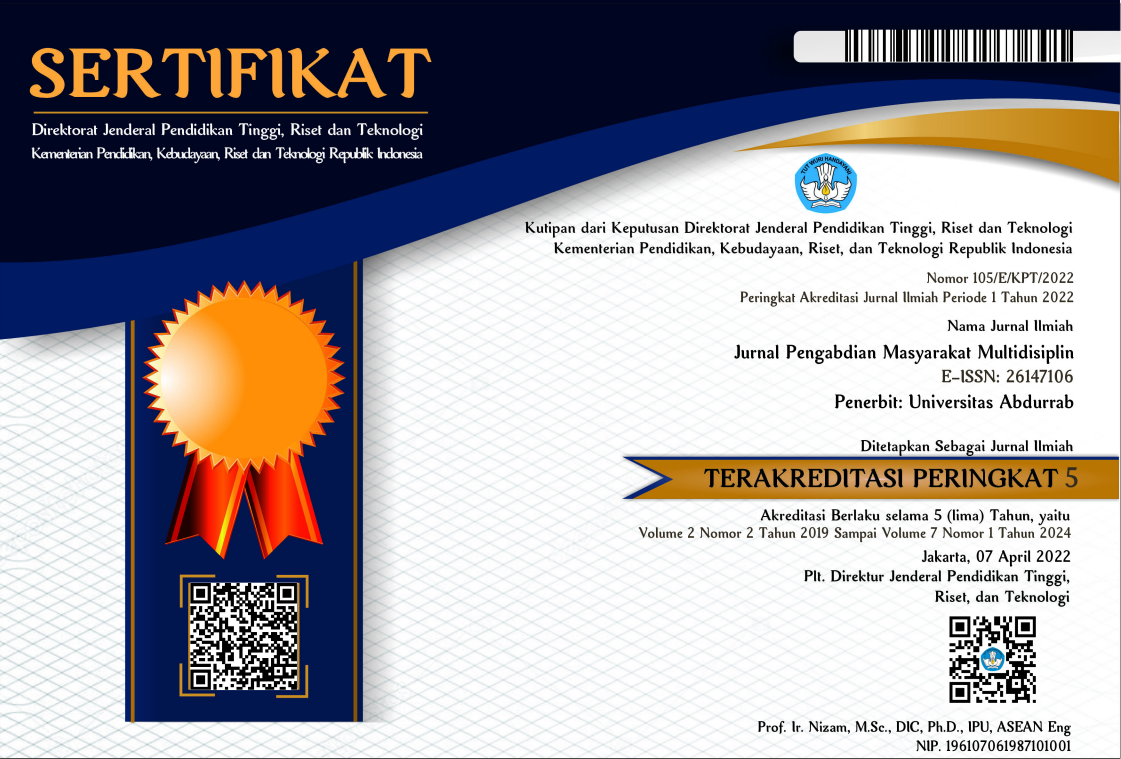PENYULUHAN MENGENAI BAHAYA PENGGUNAAN BABY WALKER DI POSYANDU KIDUL DALEM RW 4 KOTA MALANG
Abstract
Baby walkers are promoted to parents as tools that can help children learn to walk. However, research shows that this is not true. Baby walkers have been shown to slow gross motor skills and increase the incidence of injuries. This counseling was conducted with the aim of providing education to parents, especially mothers who often accompany children in health post activities regarding the dangers of using baby walkers. The counseling method uses leaflet media and there is a pretest and post-test by giving a questionnaire containing several questions about baby walkers to assess the effectiveness of counseling. The evaluation results showed an increase in knowledge with a value of 97.5% of respondents able to answer perfectly and only 2.5% who could not answer the question perfectly. This value shows that counseling on the dangers of using baby walkers has the effectiveness of increasing parents' knowledge about the effects of using baby walkers on children's motor development. In this case, the risk of children's motor development problems can be avoided.
References
J. M. Holloway and T. Long, “The interdependence of motor and social skill development: influence on participation,” Physical Therapy, vol. 99, no. 6, pp. 761–770, Jun. 2019, doi: 10.1093/ptj/pzz025.
F. Van Dellen, T. Aurich-Schuler, N. Hesse, and R. Labruyère, “Clustering trunk movements of children and adolescents with neurological gait disorders undergoing robot-assisted gait therapy: the functional ability determines if actuated pelvis movements are clinically useful,” Journal of Neuroengineering and Rehabilitation, vol. 20, no. 1, Jun. 2023, doi: 10.1186/s12984-023-01200-0.
J. Zhao et al., “Association between screen time trajectory and early childhood development in children in China,” JAMA Pediatrics, vol. 176, no. 8, p. 768, Aug. 2022, doi: 10.1001/jamapediatrics.2022.1630.
A. V. Krivova and A. N. Sharov, “Baby walkers and the phenomenon of toe-walking,” Pediatric Traumatology, Orthopaedics and Reconstructive Surgery, Mar. 2018, doi: 10.17816/ptors6123-32.
R. Schecter, D. P, and R. Milanaik, “Are baby walker warnings coming too late?: Recommendations and rationale for anticipatory guidance at earlier Well-Child visits,” Global Pediatric Health, vol. 6, p. 2333794X1987684, Jan. 2019, doi: 10.1177/2333794x19876849.
A. Sims, T. Chounthirath, J. Yang, N. L. Hodges, and G. A. Smith, “Infant Walker–Related injuries in the United States,” Pediatrics, vol. 142, no. 4, Oct. 2018, doi: 10.1542/peds.2017-4332.
A. Álvarez-álvarez et al., “Malformación de Dandy-Walker asociada a malformaciones extracraneales en un neonato,” Archivos Argentinos De Pediatria, vol. 119, no. 5, Oct. 2021, doi: 10.5546/aap.2021.e526.
C. Van Aken, M. Junger, M. Verhoeven, M. a. G. Van Aken, and M. Deković, “Externalizing behaviors and minor unintentional injuries in toddlers: common risk factors?,” Journal of Pediatric Psychology, vol. 32, no. 2, pp. 230–244, Apr. 2006, doi: 10.1093/jpepsy/jsj118
M. R. L. Pedersen, M. S. Stougaard, and B. Ibsen, “Transferring knowledge on motor development to socially vulnerable parents of infants: the practice of health visitors,” International Journal of Environmental Research and Public Health, vol. 18, no. 23, p. 12425, Nov. 2021, doi: 10.3390/ijerph182312425.
K. Benzies, J. Kurilova, and M. Van Der Merwe, “Parental Attitudinal and Behavioral Change Associated with Prevention-Focused Parenting Education: An Interpretive description,” Health Education & Behavior, vol. 50, no. 1, pp. 144–152, Oct. 2021, doi: 10.1177/10901981211033233.
S. Bezgin, K. U. Akkaya, H. I. Celik, A. D. Çamurdan, and B. Elbasan, “Investigation of the effects of using a baby walker on trunk control and motor development,” Turk Pediatri Arsivi-turkish Archives of Pediatrics, Jan. 2020, doi: 10.14744/turkpediatriars.2020.48742.
P. S. De Carvalho Chagas et al., “Effects of baby walker use on the development of gait by typically developing toddlers,” Gait & Posture, vol. 76, pp. 231–237, Feb. 2020, doi: 10.1016/j.gaitpost.2019.12.013.
P. Janusz et al., “Association between baby walker use and infant functional motor development,” Pediatric Physical Therapy, vol. 35, no. 2, pp. 237–241, Apr. 2023, doi: 10.1097/pep.0000000000000995.
S. C. Dusing et al., “Efficacy of supporting play exploration and early development Intervention in the first months of life for infants born very preterm: 3-ARM randomized clinical trial protocol,” Physical Therapy, vol. 100, no. 8, pp. 1343–1352, Apr. 2020, doi: 10.1093/ptj/pzaa077.
Copyright (c) 2024 Jurnal Pengabdian Masyarakat Multidisiplin

This work is licensed under a Creative Commons Attribution-NonCommercial-ShareAlike 4.0 International License.
1. Copyright of all journal manuscripts is held by the Jurnal Pengabdian Masyarakat Multidisiplin.Formal legal provisions to access digital articles of electronic journal are subject to the provision of the Creative
2. Commons Attribution-ShareAlike license (CC BY-NC-SA), which means that Jurnal Pengabdian Masyarakat Multidisiplin is rightful to keep, transfer media/format, manage in the form of databases, maintain, and
3. publish articles.Published manuscripts both printed and electronic are open access for educational, research, and library purposes. Additionally, the editorial board is not responsible for any violations of copyright law.
licensed under a Creative Commons Attribution-ShareAlike 4.0 International License.
 PDF (Bahasa Indonesia)
PDF (Bahasa Indonesia)
 Abstract views: 30
Abstract views: 30
 downloads: 30
downloads: 30

 :
:




